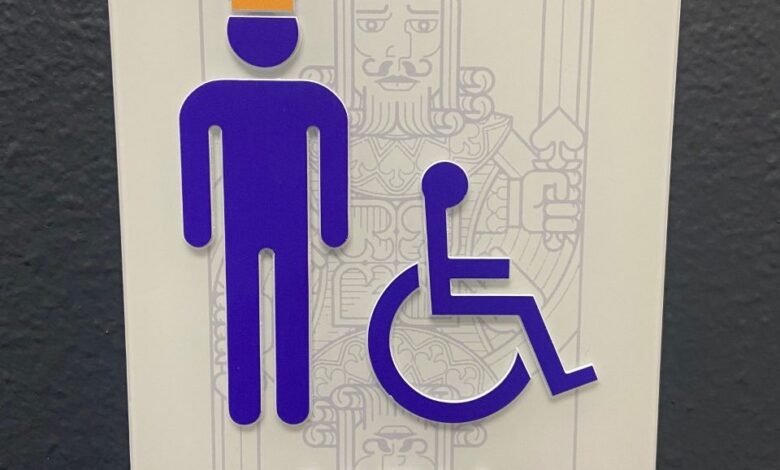Understanding ADA Signage Requirements: A Comprehensive Guide

ADA signage plays a crucial role in ensuring accessibility for all individuals, including those with disabilities. This guide explores the significance of ADA signage in promoting inclusivity, complying with legal standards, and enhancing user experience within public and private spaces.
What is ADA Signage?
Definition and Purpose
ADA signage refers to signage that complies with the Americans with Disabilities Act (ADA), designed to provide essential information in accessible formats for individuals with disabilities. These signs are essential for navigating public buildings and spaces independently and safely.
Types of ADA Signs
Room Identification Signs
These signs indicate room names or numbers, aiding in navigation and wayfinding within buildings.
Wayfinding Signs
Wayfinding signs provide directional information, guiding individuals to various destinations within a facility.
Exit Signs
Exit signs indicate emergency exits and evacuation routes, crucial for safety compliance in case of emergencies.
Informational Signs
Informational signs convey important information such as restroom locations, hours of operation, and facility rules in accessible formats.
Key Requirements of ADA Signage
Braille and Tactile Requirements
ADA signs must include raised characters and Braille to accommodate individuals with visual impairments.
Contrast and Visibility Standards
Signs must have high-contrast backgrounds and characters to ensure readability for individuals with low vision.
Mounting Height and Location Guidelines
Signs must be mounted at specific heights and locations to ensure they are accessible to individuals of varying heights and abilities.
Signage Material and Finish Considerations
Materials used for ADA signage must be durable, non-glare, and resistant to tampering or damage to maintain accessibility over time.
Designing ADA Compliant Signs
Elements of ADA Sign Design
Braille and Raised Characters
Ensure Braille and raised characters meet ADA standards for height, spacing, and readability.
Pictograms and Symbols
Use universally recognized symbols and pictograms to enhance comprehension and accessibility.
Color and Contrast
Select colors with adequate contrast to ensure readability, especially for individuals with low vision or color blindness.
Font and Text Size
Choose sans-serif fonts and appropriate text sizes to ensure legibility from various distances.
Materials Used for ADA Signage
Durable and Compliant Materials
Select materials that meet ADA requirements for durability, ease of cleaning, and resistance to environmental conditions.
Common Materials for ADA Signs
Acrylic
Acrylic is a versatile material known for its durability, clarity, and ease of customization for ADA signage.
Metal
Metal signs offer durability and a professional appearance, suitable for both indoor and outdoor ADA signage applications.
Plastic
Plastic signs are lightweight, cost-effective, and available in a variety of colors, making them ideal for ADA compliance.
ADA-compliant Braille materials
Specialized materials are used for Braille, ensuring tactile readability and compliance with ADA standards.
Placement and Installation of ADA Signs
Location Requirements
Place ADA signs in locations that are easily identifiable and within reach of individuals using mobility aids.
Height and Reach Guidelines
Install signs at specific heights and locations to ensure they are accessible to individuals of varying abilities.
Installation Methods
Follow ADA guidelines for mounting methods to ensure signs are securely attached and properly aligned.
Signage Maintenance and Inspection
Implement regular maintenance schedules to inspect signs for damage, cleanliness, and compliance with ADA standards.
Benefits of ADA Compliant Signage
Enhanced Accessibility
ADA signage promotes independence and accessibility for individuals with disabilities, facilitating safe navigation within public and private spaces.
Legal Compliance
Compliance with ADA signage requirements ensures businesses and facilities adhere to federal regulations, avoiding penalties and legal liabilities.
Improved User Experience
Accessible signage enhances the overall user experience by providing clear information and directions to all individuals.
Supporting Diversity and Inclusion
ADA signage demonstrates a commitment to diversity and inclusion, fostering a welcoming environment for everyone.
Common ADA Signage Mistakes to Avoid
Poor Contrast or Visibility
Inadequate contrast or visibility makes signs difficult to read for individuals with visual impairments.
Incorrect Braille or Raised Character Specifications
Errors in Braille or raised character specifications can render signs inaccessible and non-compliant.
Improper Installation or Placement
Incorrect installation or placement of signs can obstruct accessibility and compromise safety.
Non-compliant Material Choices
Using materials that do not meet ADA standards for durability or tactile readability undermines accessibility efforts.
Case Studies of Effective ADA Signage Implementation
Real-life Examples
Explore successful implementations of ADA signage in various settings, showcasing effective design and compliance strategies.
Success Stories in Compliance and Design
Analyze case studies to understand how businesses and organizations achieve ADA compliance while enhancing user experience.
Frequently Asked Questions (FAQs)
Q1: What are ADA signage requirements?
ADA signage requirements include specifications for Braille, raised characters, contrast, and mounting height to ensure accessibility.
Q2: How do I make my signage ADA compliant?
Ensure signage meets ADA standards for design elements, materials, installation, and maintenance.
Q3: Do all businesses need ADA signage?
Businesses and facilities open to the public are required to have ADA signage to ensure accessibility for all individuals.
Q4: What are the penalties for not having ADA compliant signage?
Penalties for non-compliance with ADA signage requirements can include fines and legal action.
Q5: Can ADA signage be customized for branding purposes?
Yes, ADA signage can incorporate branding elements such as colors and logos while still meeting accessibility requirements.
Conclusion
ADA signage is essential for promoting accessibility, ensuring compliance with federal regulations, and enhancing user experience within public and private spaces. By adhering to ADA standards in design, materials, placement, and maintenance, businesses and organizations can create inclusive environments that benefit all individuals, regardless of ability. Investing in ADA compliant signage not only meets legal obligations but also demonstrates a commitment to accessibility and inclusivity in today’s diverse society.



